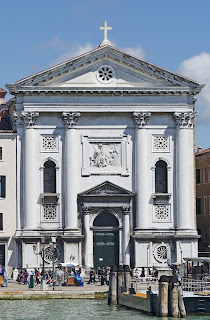Opera composer who gave Vivaldi a job
 |
| Francesco Gasparini, captured in a caricature by Pier Leone Ghezzi |
Gasparini also worked as a music teacher and was musical director of the Ospedale della Pietà in Venice for about 15 years, where he made the inspired decision to employ a 25-year-old Antonio Vivaldi as a violin master.
By the age of 17, Gasparini was a member of the Philharmonic Academy of Bologna. He moved to Rome, where he studied under the musicians Arcangelo Corelli and Bernardo Pasquini. His first important opera, Roderico, was produced there in 1694.
After arriving in Venice in 1702, he became one of the leading composers in the city. He wrote the first opera to use the story of Hamlet - Ambleto - in 1705, although he did not base the work on Shakespeare’s play.
Gasparini was appointed musical director of the Ospedale della Pietà, an orphanage in Venice where young girls received a musical education. The most talented pupils stayed on to become members of the Ospedale’s orchestra and choir.
Listen: Excerpt from Gasparini's "Amore e Ombre"
He engaged the services of Antonio Vivaldi in 1703 to teach the violin. Vivaldi, who had been taught to play the violin to a high level by his father, composed most of his major works while working there over the next 30 years.
 |
| Gasparini hired Antonio Vivaldi to teach violin at the Ospedale della Pietà, in Venice |
While in Venice, Gasparini also taught the Venetian composer Benedetto Marcello and wrote a treatise on the harpsichord, published in 1708, which continued to be reprinted for more than 100 years and was used in Italy well into the 19th century.
Gasparini was the leading composer for the theatre in Venice, having written 23 operas and 15 oratorios by the time he left the city.
After his return to Rome in about 1720, he was maestro di cappello in two churches and taught the Neapolitan composer Domenico Scarlatti. He also taught counterpoint to the German flautist and composer Johann Joachim Quantz.
In his day, Gasparini was the principal composer of the Italian operas presented in London. His last important work, Tigrane, was produced in Rome in 1724.
The composer died in Rome in 1727, aged 66.
| Piazza Principale, the main square in Camaiore |
Camaiore, the birthplace of Francesco Gasparini, is a city within the province of Lucca in Tuscany. It derives its name from the time it was a large Roman encampment, Campus Major, and an important station along the Via Cassia. It has two Romanesque churches, the Collegiata di Santa Maria Assunta and the Church of Santi Giovanni e Stefano as well as a Benedictine Abbey, Badia di San Pietro, that dates back to the eighth century.
 |
| The church of La Pietà, also known as Santa Maria della Visitazione, in Venice |
The Church of La Pietà, or Santa Maria della Visitazione, on Riva degli Schiavoni facing the lagoon in Venice, dates back to the 15th century. It started its life as a foundling home for orphans. After Gasparini was appointed musical director there, he employed Vivaldi to teach the violin and they both composed music for the orchestra and choir. The church is now a regular venue for music concerts.
Find a Venice hotel with Tripadvisor
More reading:
How Vivaldi enjoyed success but died a pauper
Why composer Antonio Salieri was haunted by rumours surrounding the death of rival Mozart
The lost operas of Tomaso Albinoni
Also on this day:
1923: The birth of cartoonist Benito Jacovitti
1943: The birth of former prime minister Mario Monti
Home
More reading:
How Vivaldi enjoyed success but died a pauper
Why composer Antonio Salieri was haunted by rumours surrounding the death of rival Mozart
The lost operas of Tomaso Albinoni
Also on this day:
1923: The birth of cartoonist Benito Jacovitti
1943: The birth of former prime minister Mario Monti
Home

